BTEC HND Computing: Software Development Life Cycle Models Report
VerifiedAdded on 2022/03/02
|37
|7409
|54
Report
AI Summary
This report provides a comprehensive overview of Software Development Life Cycle (SDLC) models, including Waterfall, Prototyping, Spiral, and Agile. It details the phases, advantages, and disadvantages of each model. The report also explains risk management within the Spiral model, discussing risk management processes and their application. Furthermore, it explores the importance of feasibility reports, outlining their purpose, components, and the comparison of technical solutions. The assignment concludes with a discussion on assessing the impact of feasibility criteria for a software survey, offering a detailed analysis of the SDLC and its practical applications. The report is a detailed analysis of software development methodologies and processes.
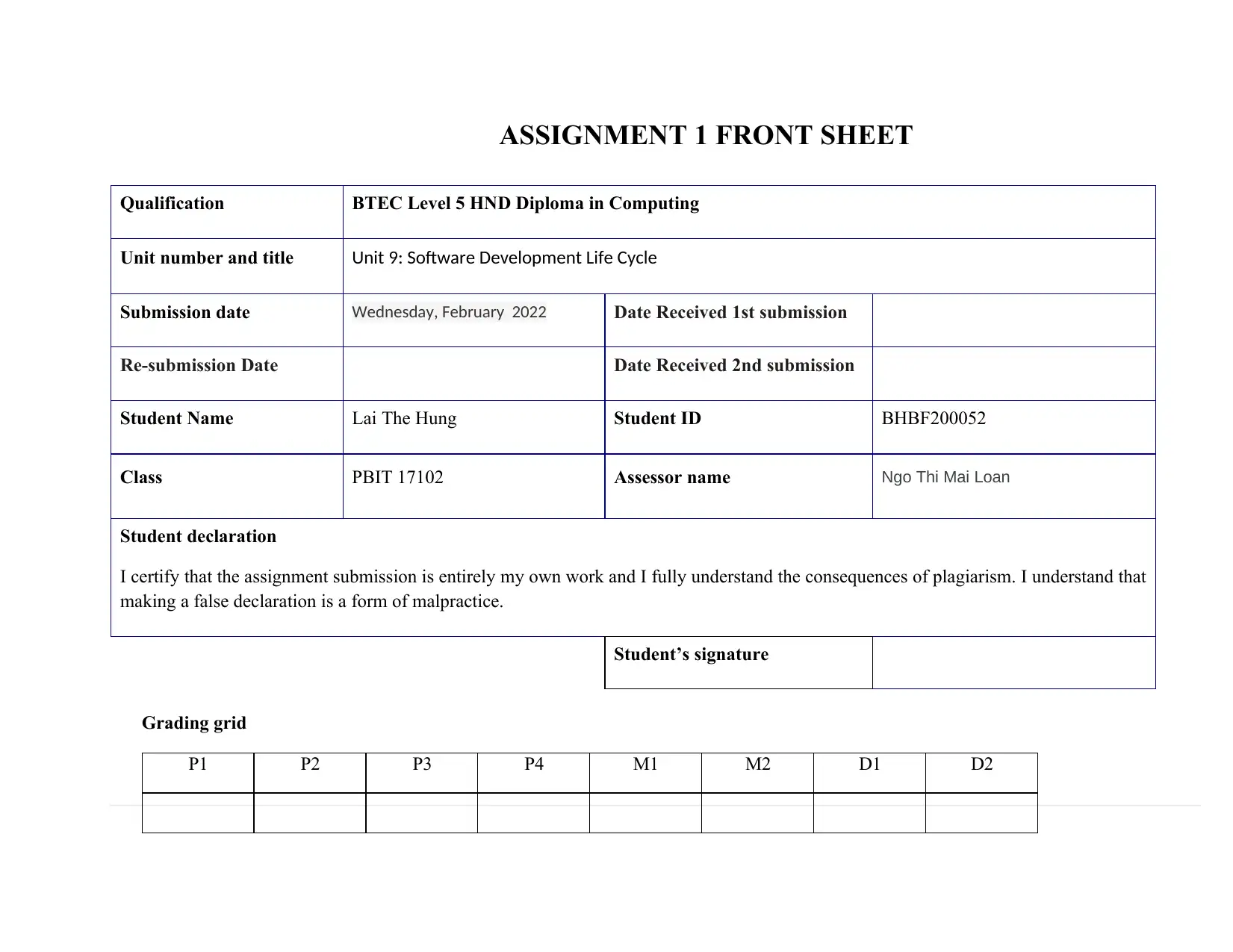
ASSIGNMENT 1 FRONT SHEET
Qualification BTEC Level 5 HND Diploma in Computing
Unit number and title Unit 9: Software Development Life Cycle
Submission date Wednesday, February 2022 Date Received 1st submission
Re-submission Date Date Received 2nd submission
Student Name Lai The Hung Student ID BHBF200052
Class PBIT 17102 Assessor name Ngo Thi Mai Loan
Student declaration
I certify that the assignment submission is entirely my own work and I fully understand the consequences of plagiarism. I understand that
making a false declaration is a form of malpractice.
Student’s signature
Grading grid
P1 P2 P3 P4 M1 M2 D1 D2
Qualification BTEC Level 5 HND Diploma in Computing
Unit number and title Unit 9: Software Development Life Cycle
Submission date Wednesday, February 2022 Date Received 1st submission
Re-submission Date Date Received 2nd submission
Student Name Lai The Hung Student ID BHBF200052
Class PBIT 17102 Assessor name Ngo Thi Mai Loan
Student declaration
I certify that the assignment submission is entirely my own work and I fully understand the consequences of plagiarism. I understand that
making a false declaration is a form of malpractice.
Student’s signature
Grading grid
P1 P2 P3 P4 M1 M2 D1 D2
Paraphrase This Document
Need a fresh take? Get an instant paraphrase of this document with our AI Paraphraser
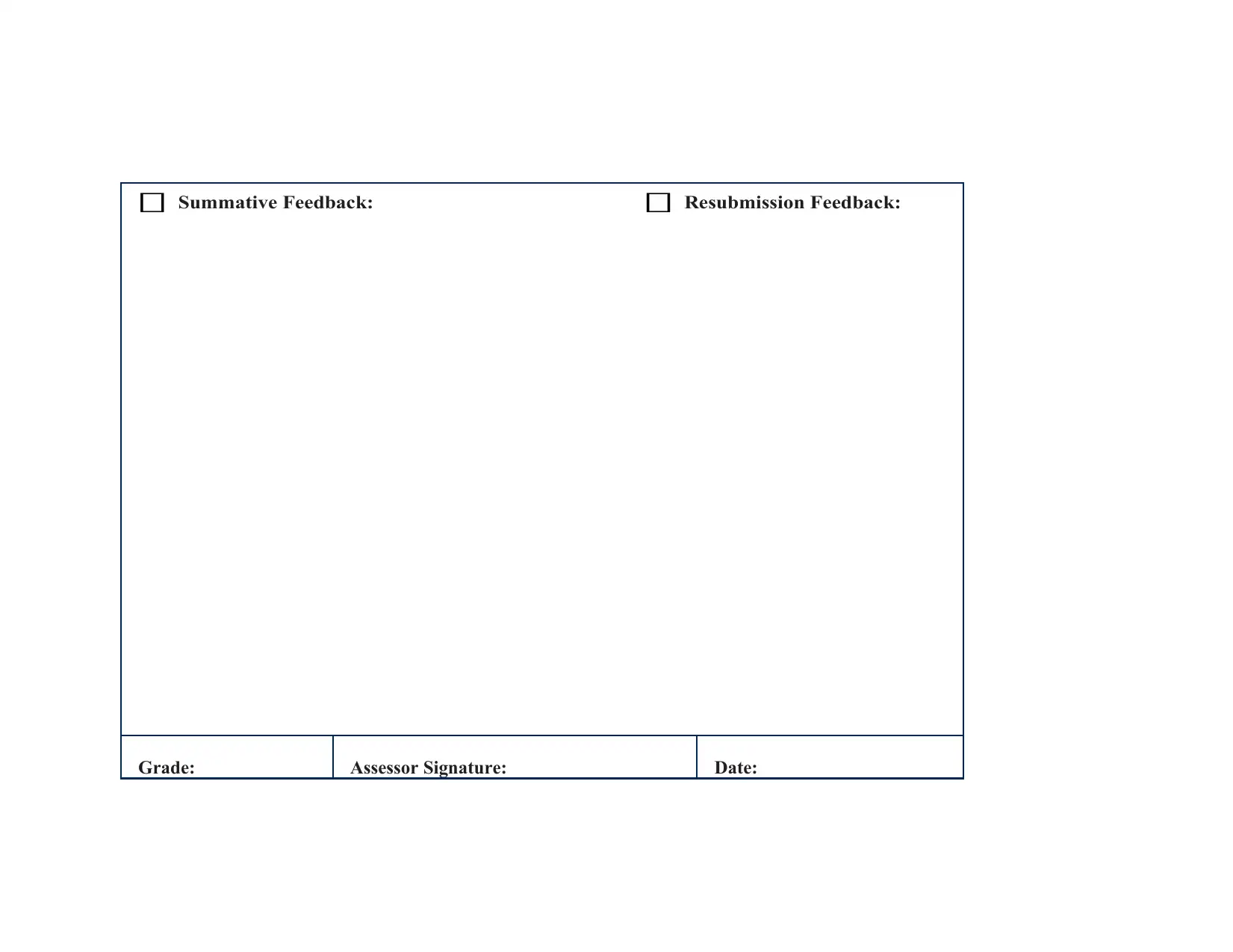
Summative Feedback: Resubmission Feedback:
Grade: Assessor Signature: Date:
Grade: Assessor Signature: Date:
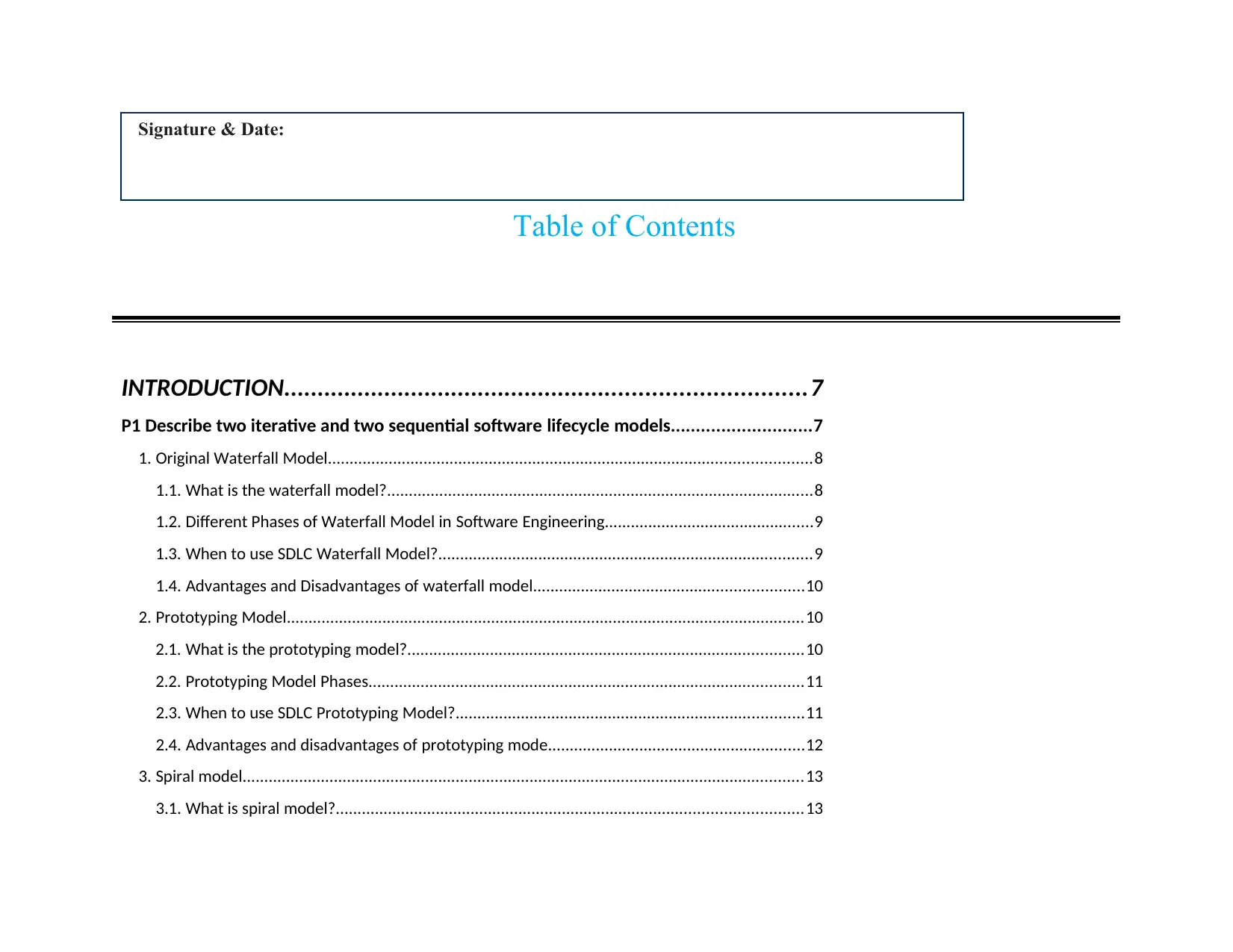
Signature & Date:
Table of Contents
INTRODUCTION..............................................................................7
P1 Describe two iterative and two sequential software lifecycle models............................7
1. Original Waterfall Model...............................................................................................................8
1.1. What is the waterfall model?..................................................................................................8
1.2. Different Phases of Waterfall Model in Software Engineering................................................9
1.3. When to use SDLC Waterfall Model?......................................................................................9
1.4. Advantages and Disadvantages of waterfall model..............................................................10
2. Prototyping Model.......................................................................................................................10
2.1. What is the prototyping model?...........................................................................................10
2.2. Prototyping Model Phases....................................................................................................11
2.3. When to use SDLC Prototyping Model?................................................................................11
2.4. Advantages and disadvantages of prototyping mode...........................................................12
3. Spiral model.................................................................................................................................13
3.1. What is spiral model?...........................................................................................................13
Table of Contents
INTRODUCTION..............................................................................7
P1 Describe two iterative and two sequential software lifecycle models............................7
1. Original Waterfall Model...............................................................................................................8
1.1. What is the waterfall model?..................................................................................................8
1.2. Different Phases of Waterfall Model in Software Engineering................................................9
1.3. When to use SDLC Waterfall Model?......................................................................................9
1.4. Advantages and Disadvantages of waterfall model..............................................................10
2. Prototyping Model.......................................................................................................................10
2.1. What is the prototyping model?...........................................................................................10
2.2. Prototyping Model Phases....................................................................................................11
2.3. When to use SDLC Prototyping Model?................................................................................11
2.4. Advantages and disadvantages of prototyping mode...........................................................12
3. Spiral model.................................................................................................................................13
3.1. What is spiral model?...........................................................................................................13
⊘ This is a preview!⊘
Do you want full access?
Subscribe today to unlock all pages.

Trusted by 1+ million students worldwide
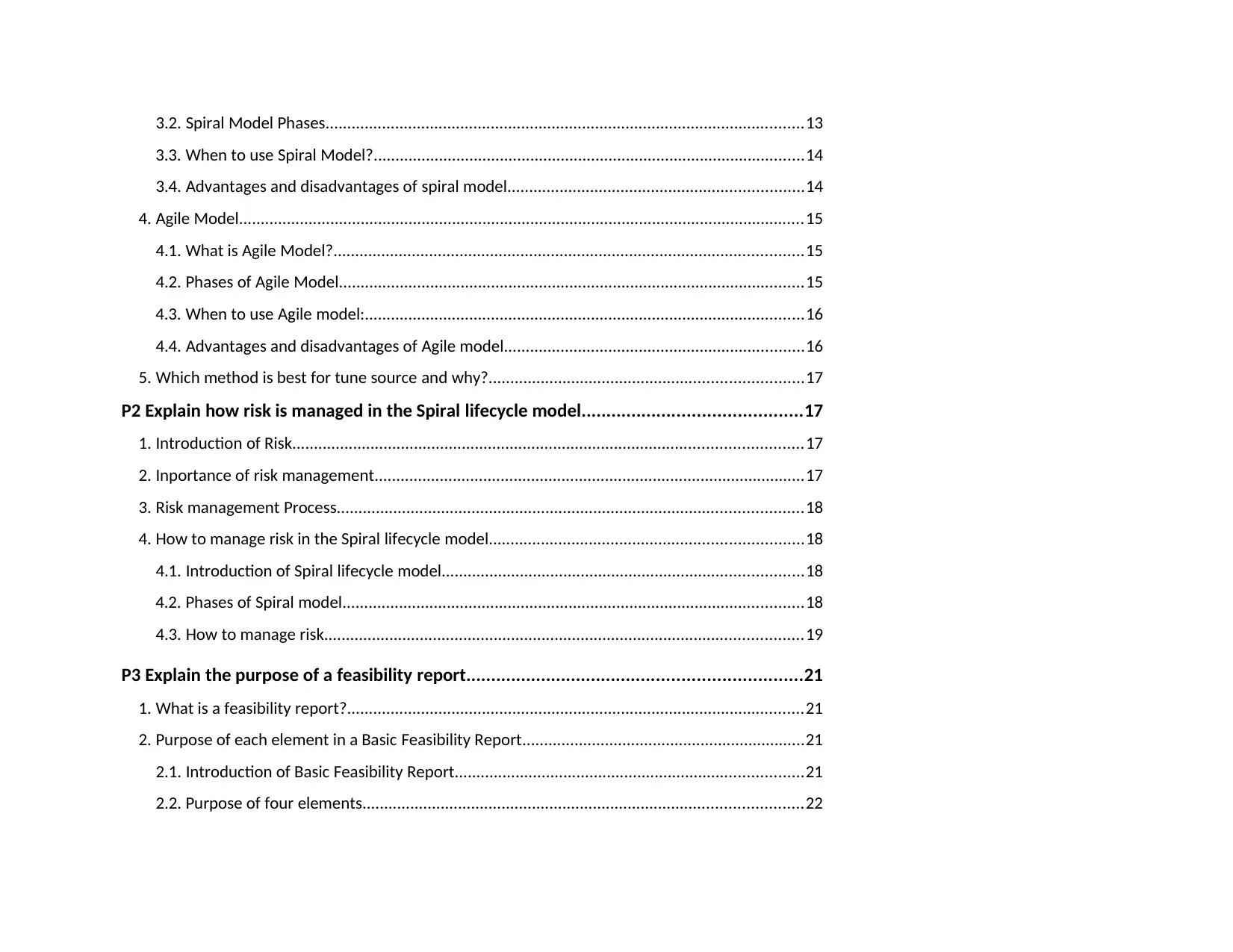
3.2. Spiral Model Phases..............................................................................................................13
3.3. When to use Spiral Model?...................................................................................................14
3.4. Advantages and disadvantages of spiral model....................................................................14
4. Agile Model..................................................................................................................................15
4.1. What is Agile Model?............................................................................................................15
4.2. Phases of Agile Model...........................................................................................................15
4.3. When to use Agile model:.....................................................................................................16
4.4. Advantages and disadvantages of Agile model.....................................................................16
5. Which method is best for tune source and why?........................................................................17
P2 Explain how risk is managed in the Spiral lifecycle model............................................17
1. Introduction of Risk.....................................................................................................................17
2. Inportance of risk management...................................................................................................17
3. Risk management Process...........................................................................................................18
4. How to manage risk in the Spiral lifecycle model........................................................................18
4.1. Introduction of Spiral lifecycle model...................................................................................18
4.2. Phases of Spiral model..........................................................................................................18
4.3. How to manage risk..............................................................................................................19
P3 Explain the purpose of a feasibility report...................................................................21
1. What is a feasibility report?.........................................................................................................21
2. Purpose of each element in a Basic Feasibility Report.................................................................21
2.1. Introduction of Basic Feasibility Report................................................................................21
2.2. Purpose of four elements.....................................................................................................22
3.3. When to use Spiral Model?...................................................................................................14
3.4. Advantages and disadvantages of spiral model....................................................................14
4. Agile Model..................................................................................................................................15
4.1. What is Agile Model?............................................................................................................15
4.2. Phases of Agile Model...........................................................................................................15
4.3. When to use Agile model:.....................................................................................................16
4.4. Advantages and disadvantages of Agile model.....................................................................16
5. Which method is best for tune source and why?........................................................................17
P2 Explain how risk is managed in the Spiral lifecycle model............................................17
1. Introduction of Risk.....................................................................................................................17
2. Inportance of risk management...................................................................................................17
3. Risk management Process...........................................................................................................18
4. How to manage risk in the Spiral lifecycle model........................................................................18
4.1. Introduction of Spiral lifecycle model...................................................................................18
4.2. Phases of Spiral model..........................................................................................................18
4.3. How to manage risk..............................................................................................................19
P3 Explain the purpose of a feasibility report...................................................................21
1. What is a feasibility report?.........................................................................................................21
2. Purpose of each element in a Basic Feasibility Report.................................................................21
2.1. Introduction of Basic Feasibility Report................................................................................21
2.2. Purpose of four elements.....................................................................................................22
Paraphrase This Document
Need a fresh take? Get an instant paraphrase of this document with our AI Paraphraser
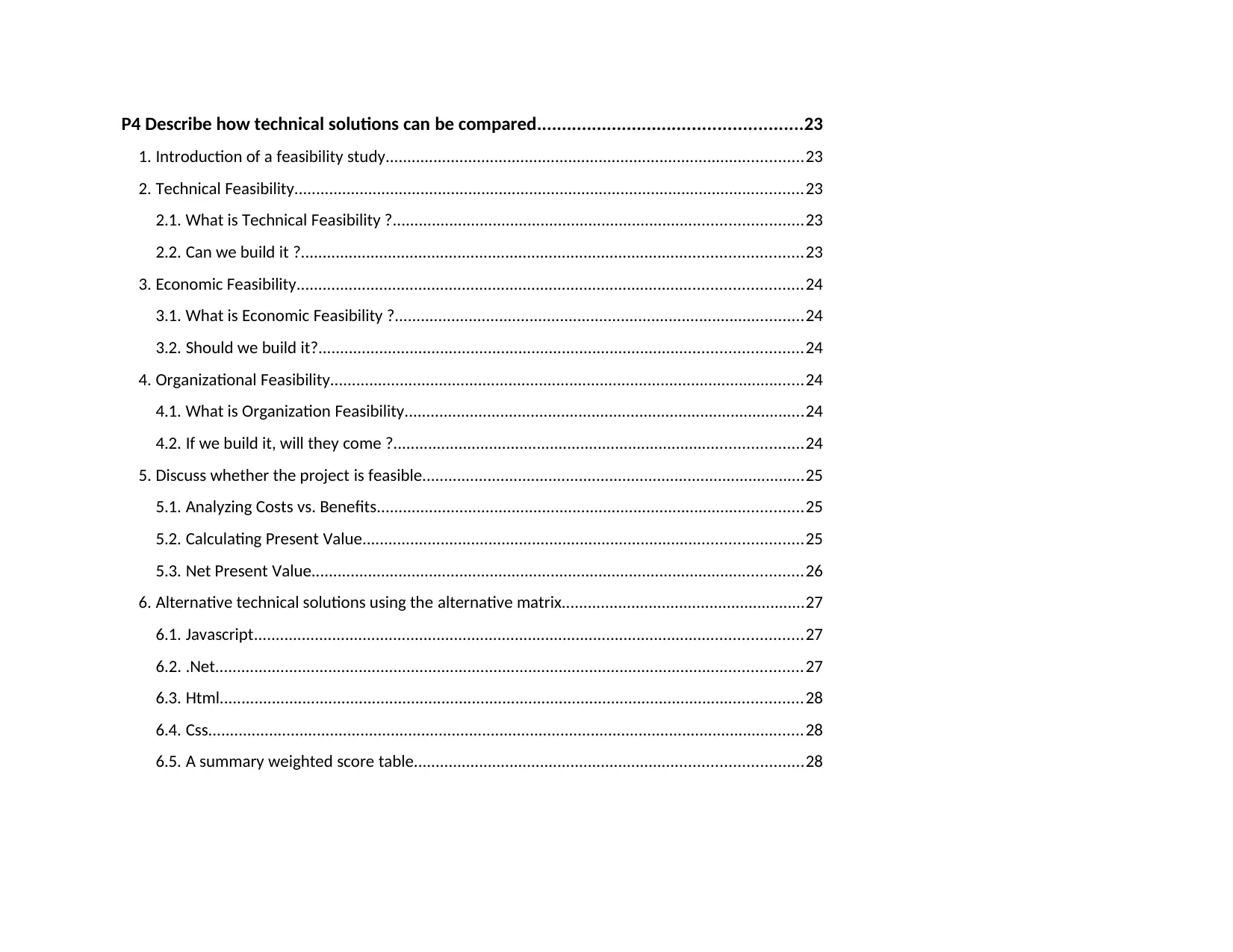
P4 Describe how technical solutions can be compared.....................................................23
1. Introduction of a feasibility study................................................................................................23
2. Technical Feasibility.....................................................................................................................23
2.1. What is Technical Feasibility ?..............................................................................................23
2.2. Can we build it ?...................................................................................................................23
3. Economic Feasibility....................................................................................................................24
3.1. What is Economic Feasibility ?..............................................................................................24
3.2. Should we build it?...............................................................................................................24
4. Organizational Feasibility.............................................................................................................24
4.1. What is Organization Feasibility............................................................................................24
4.2. If we build it, will they come ?..............................................................................................24
5. Discuss whether the project is feasible........................................................................................25
5.1. Analyzing Costs vs. Benefits..................................................................................................25
5.2. Calculating Present Value.....................................................................................................25
5.3. Net Present Value.................................................................................................................26
6. Alternative technical solutions using the alternative matrix........................................................27
6.1. Javascript..............................................................................................................................27
6.2. .Net.......................................................................................................................................27
6.3. Html......................................................................................................................................28
6.4. Css.........................................................................................................................................28
6.5. A summary weighted score table.........................................................................................28
1. Introduction of a feasibility study................................................................................................23
2. Technical Feasibility.....................................................................................................................23
2.1. What is Technical Feasibility ?..............................................................................................23
2.2. Can we build it ?...................................................................................................................23
3. Economic Feasibility....................................................................................................................24
3.1. What is Economic Feasibility ?..............................................................................................24
3.2. Should we build it?...............................................................................................................24
4. Organizational Feasibility.............................................................................................................24
4.1. What is Organization Feasibility............................................................................................24
4.2. If we build it, will they come ?..............................................................................................24
5. Discuss whether the project is feasible........................................................................................25
5.1. Analyzing Costs vs. Benefits..................................................................................................25
5.2. Calculating Present Value.....................................................................................................25
5.3. Net Present Value.................................................................................................................26
6. Alternative technical solutions using the alternative matrix........................................................27
6.1. Javascript..............................................................................................................................27
6.2. .Net.......................................................................................................................................27
6.3. Html......................................................................................................................................28
6.4. Css.........................................................................................................................................28
6.5. A summary weighted score table.........................................................................................28
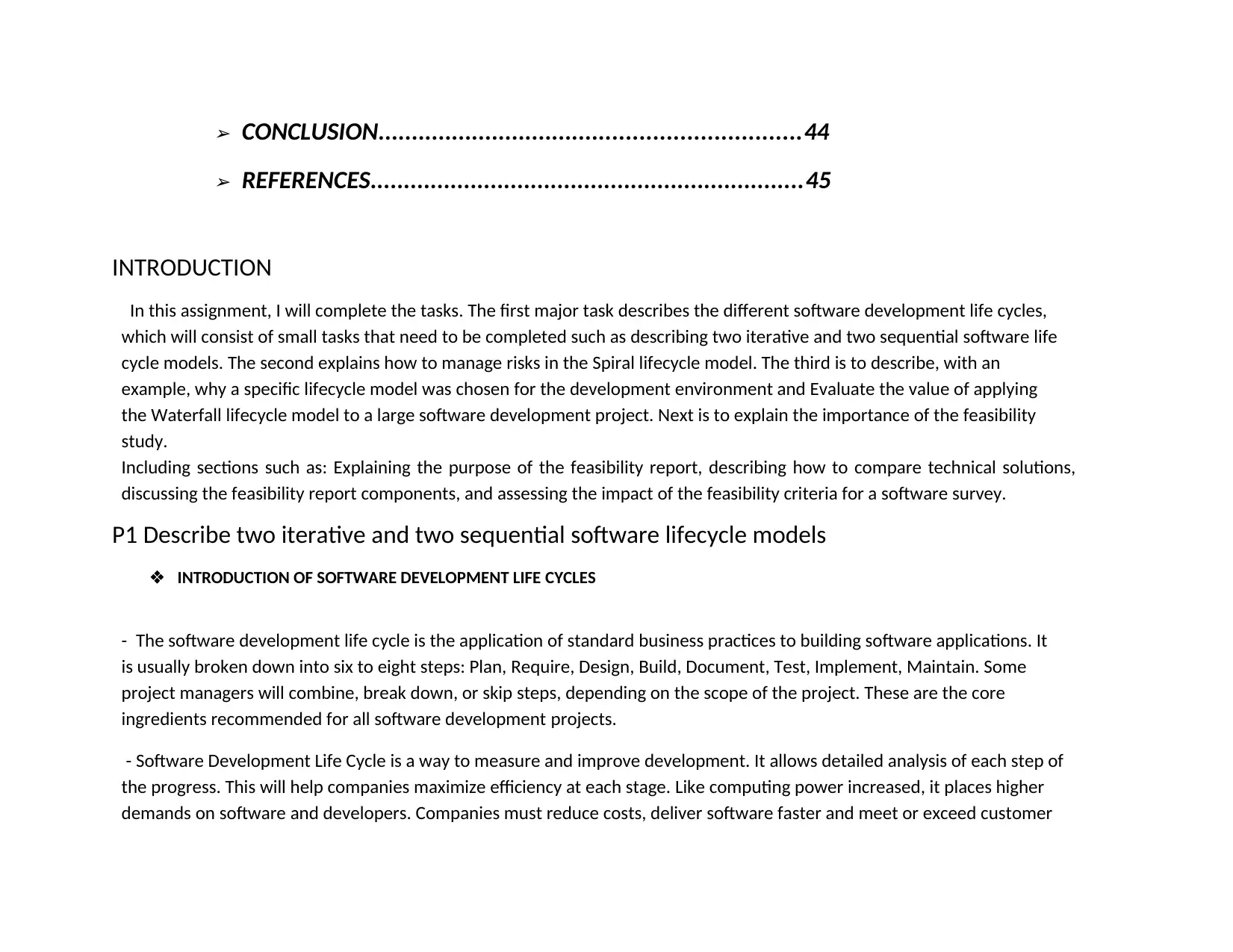
➢ CONCLUSION...............................................................44➢ REFERENCES.................................................................45
INTRODUCTION
In this assignment, I will complete the tasks. The first major task describes the different software development life cycles,
which will consist of small tasks that need to be completed such as describing two iterative and two sequential software life
cycle models. The second explains how to manage risks in the Spiral lifecycle model. The third is to describe, with an
example, why a specific lifecycle model was chosen for the development environment and Evaluate the value of applying
the Waterfall lifecycle model to a large software development project. Next is to explain the importance of the feasibility
study.
Including sections such as: Explaining the purpose of the feasibility report, describing how to compare technical solutions,
discussing the feasibility report components, and assessing the impact of the feasibility criteria for a software survey.
P1 Describe two iterative and two sequential software lifecycle models
INTRODUCTION OF SOFTWARE DEVELOPMENT LIFE CYCLES
- The software development life cycle is the application of standard business practices to building software applications. It
is usually broken down into six to eight steps: Plan, Require, Design, Build, Document, Test, Implement, Maintain. Some
project managers will combine, break down, or skip steps, depending on the scope of the project. These are the core
ingredients recommended for all software development projects.
- Software Development Life Cycle is a way to measure and improve development. It allows detailed analysis of each step of
the progress. This will help companies maximize efficiency at each stage. Like computing power increased, it places higher
demands on software and developers. Companies must reduce costs, deliver software faster and meet or exceed customer
INTRODUCTION
In this assignment, I will complete the tasks. The first major task describes the different software development life cycles,
which will consist of small tasks that need to be completed such as describing two iterative and two sequential software life
cycle models. The second explains how to manage risks in the Spiral lifecycle model. The third is to describe, with an
example, why a specific lifecycle model was chosen for the development environment and Evaluate the value of applying
the Waterfall lifecycle model to a large software development project. Next is to explain the importance of the feasibility
study.
Including sections such as: Explaining the purpose of the feasibility report, describing how to compare technical solutions,
discussing the feasibility report components, and assessing the impact of the feasibility criteria for a software survey.
P1 Describe two iterative and two sequential software lifecycle models
INTRODUCTION OF SOFTWARE DEVELOPMENT LIFE CYCLES
- The software development life cycle is the application of standard business practices to building software applications. It
is usually broken down into six to eight steps: Plan, Require, Design, Build, Document, Test, Implement, Maintain. Some
project managers will combine, break down, or skip steps, depending on the scope of the project. These are the core
ingredients recommended for all software development projects.
- Software Development Life Cycle is a way to measure and improve development. It allows detailed analysis of each step of
the progress. This will help companies maximize efficiency at each stage. Like computing power increased, it places higher
demands on software and developers. Companies must reduce costs, deliver software faster and meet or exceed customer
⊘ This is a preview!⊘
Do you want full access?
Subscribe today to unlock all pages.

Trusted by 1+ million students worldwide
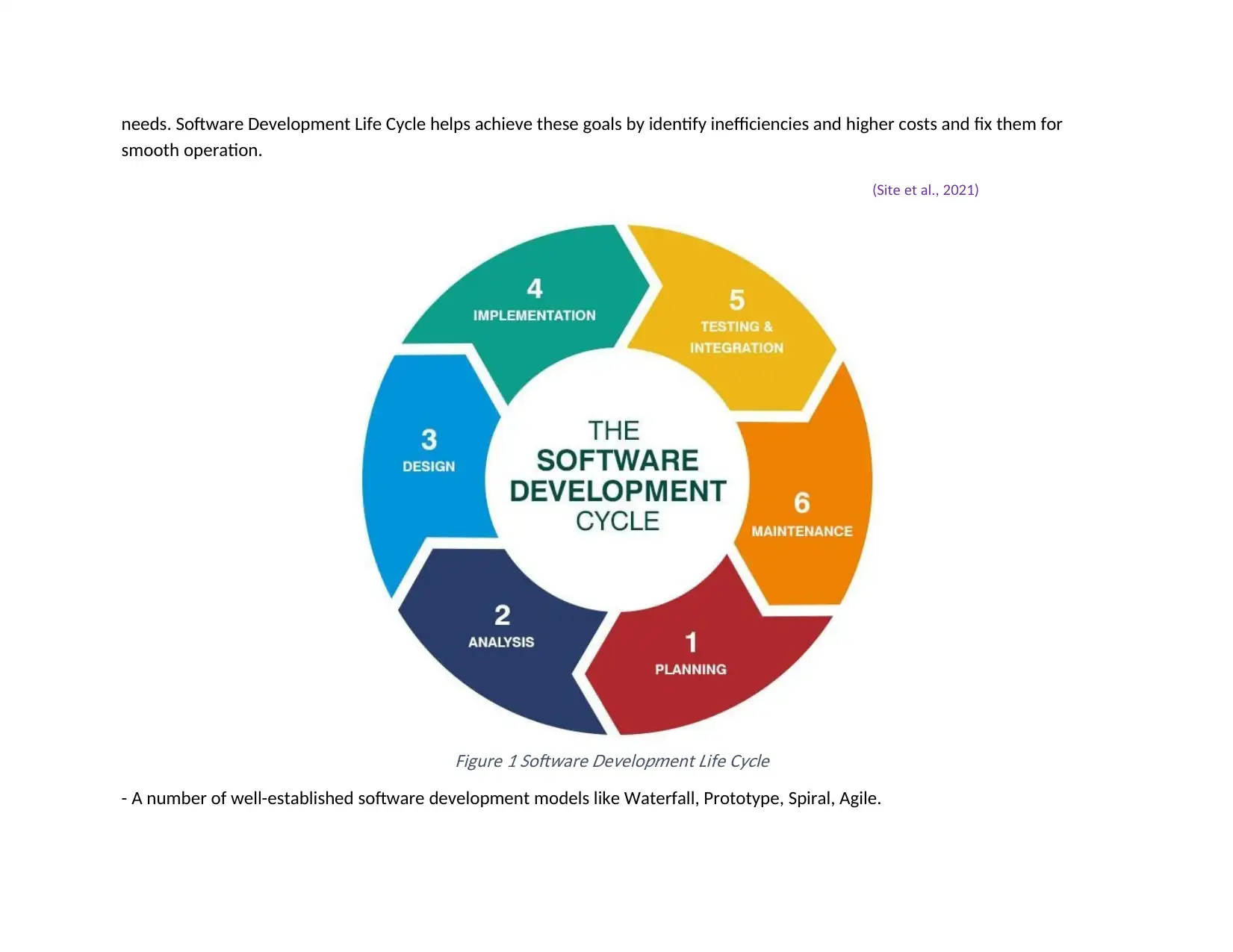
needs. Software Development Life Cycle helps achieve these goals by identify inefficiencies and higher costs and fix them for
smooth operation.
ite et al(S ., 2021)
Figure oft are e elo ent ife C le
1 S w D v pm L yc
- A number of well-established software development models like Waterfall, Prototype, Spiral, Agile.
smooth operation.
ite et al(S ., 2021)
Figure oft are e elo ent ife C le
1 S w D v pm L yc
- A number of well-established software development models like Waterfall, Prototype, Spiral, Agile.
Paraphrase This Document
Need a fresh take? Get an instant paraphrase of this document with our AI Paraphraser

1. Original Waterfall Model
1.1 What is the waterfall model?
aterfall ModelW is a se uential odel t at di ides soft are de elo ent into re defined ases a ase ust beq m h v w v pm p - ph . E ch ph m
o leted before t e ne t ase an begin it no o erla bet een t e ases a ase is designed for erfor ingc mp h x ph c w h v p w h ph . E ch ph p m
s e ifi a ti it during t e C ase t as introdu ed in b instonp c c c v y h SDL ph . I w c 1970 y W o eR yc .
at is aterfall Model in C d antages and isad antages(Wh W SDL ? A v D v , 2021)
Figure riginal aterfall Model
2 O W
1.1 What is the waterfall model?
aterfall ModelW is a se uential odel t at di ides soft are de elo ent into re defined ases a ase ust beq m h v w v pm p - ph . E ch ph m
o leted before t e ne t ase an begin it no o erla bet een t e ases a ase is designed for erfor ingc mp h x ph c w h v p w h ph . E ch ph p m
s e ifi a ti it during t e C ase t as introdu ed in b instonp c c c v y h SDL ph . I w c 1970 y W o eR yc .
at is aterfall Model in C d antages and isad antages(Wh W SDL ? A v D v , 2021)
Figure riginal aterfall Model
2 O W
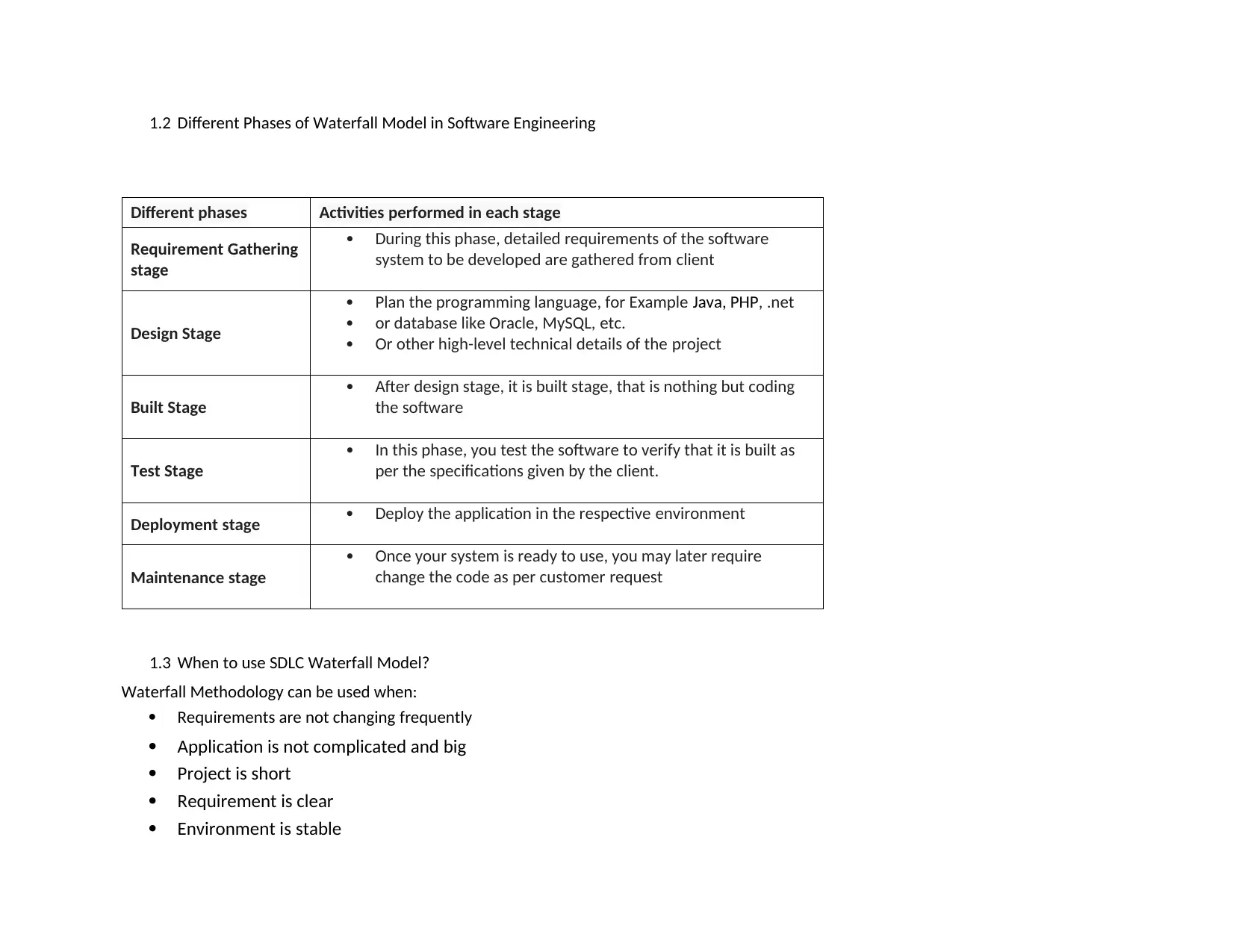
1.2 Different Phases of Waterfall Model in Software Engineering
Different phases Activities performed in each stage
Requirement Gathering
stage
During this phase, detailed requirements of the software
system to be developed are gathered from client
Design Stage
Plan the programming language, for Example Java, PHP, .net
or database like Oracle, MySQL, etc.
Or other high-level technical details of the project
Built Stage
After design stage, it is built stage, that is nothing but coding
the software
Test Stage
In this phase, you test the software to verify that it is built as
per the specifications given by the client.
Deployment stage Deploy the application in the respective environment
Maintenance stage
Once your system is ready to use, you may later require
change the code as per customer request
1.3 When to use SDLC Waterfall Model?
Waterfall Methodology can be used when:
Requirements are not changing frequently
Application is not complicated and big
Project is short
Requirement is clear
Environment is stable
Different phases Activities performed in each stage
Requirement Gathering
stage
During this phase, detailed requirements of the software
system to be developed are gathered from client
Design Stage
Plan the programming language, for Example Java, PHP, .net
or database like Oracle, MySQL, etc.
Or other high-level technical details of the project
Built Stage
After design stage, it is built stage, that is nothing but coding
the software
Test Stage
In this phase, you test the software to verify that it is built as
per the specifications given by the client.
Deployment stage Deploy the application in the respective environment
Maintenance stage
Once your system is ready to use, you may later require
change the code as per customer request
1.3 When to use SDLC Waterfall Model?
Waterfall Methodology can be used when:
Requirements are not changing frequently
Application is not complicated and big
Project is short
Requirement is clear
Environment is stable
⊘ This is a preview!⊘
Do you want full access?
Subscribe today to unlock all pages.

Trusted by 1+ million students worldwide
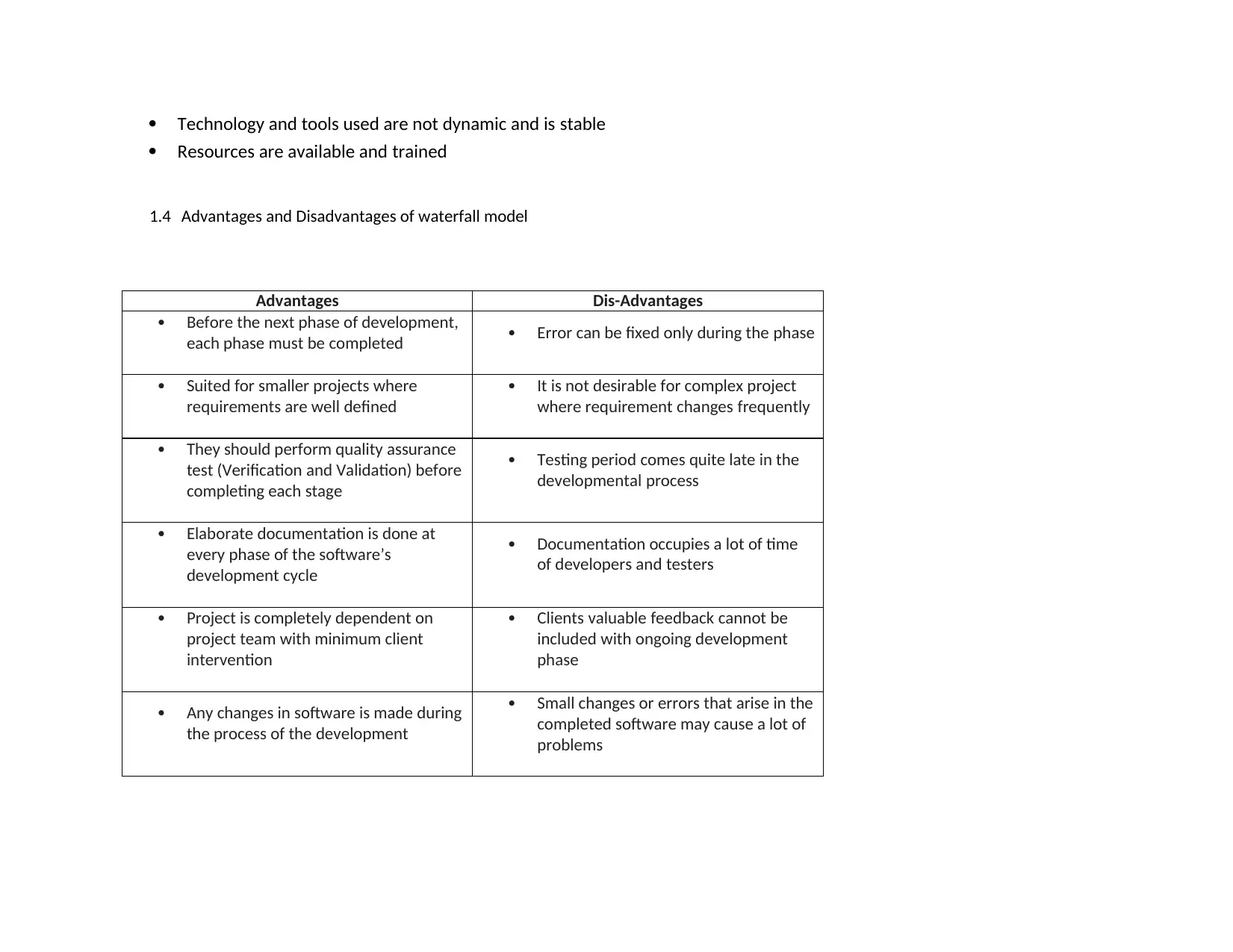
Technology and tools used are not dynamic and is stable
Resources are available and trained
1.4 Advantages and Disadvantages of waterfall model
Advantages Dis-Advantages
Before the next phase of development,
each phase must be completed Error can be fixed only during the phase
Suited for smaller projects where
requirements are well defined
It is not desirable for complex project
where requirement changes frequently
They should perform quality assurance
test (Verification and Validation) before
completing each stage
Testing period comes quite late in the
developmental process
Elaborate documentation is done at
every phase of the software’s
development cycle
Documentation occupies a lot of time
of developers and testers
Project is completely dependent on
project team with minimum client
intervention
Clients valuable feedback cannot be
included with ongoing development
phase
Any changes in software is made during
the process of the development
Small changes or errors that arise in the
completed software may cause a lot of
problems
Resources are available and trained
1.4 Advantages and Disadvantages of waterfall model
Advantages Dis-Advantages
Before the next phase of development,
each phase must be completed Error can be fixed only during the phase
Suited for smaller projects where
requirements are well defined
It is not desirable for complex project
where requirement changes frequently
They should perform quality assurance
test (Verification and Validation) before
completing each stage
Testing period comes quite late in the
developmental process
Elaborate documentation is done at
every phase of the software’s
development cycle
Documentation occupies a lot of time
of developers and testers
Project is completely dependent on
project team with minimum client
intervention
Clients valuable feedback cannot be
included with ongoing development
phase
Any changes in software is made during
the process of the development
Small changes or errors that arise in the
completed software may cause a lot of
problems
Paraphrase This Document
Need a fresh take? Get an instant paraphrase of this document with our AI Paraphraser
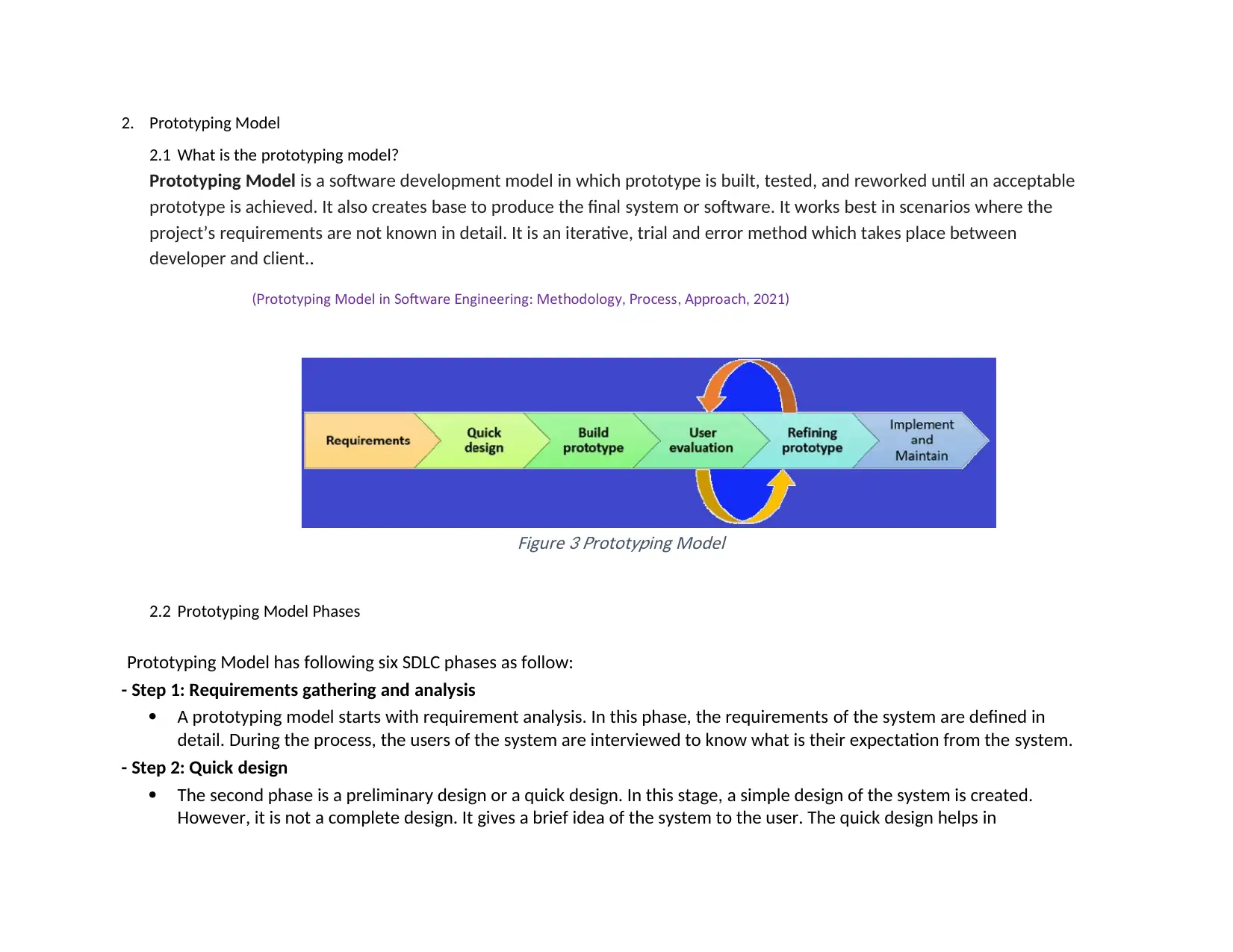
2. Prototyping Model
2.1 What is the prototyping model?
Prototyping Model is a software development model in which prototype is built, tested, and reworked until an acceptable
prototype is achieved. It also creates base to produce the final system or software. It works best in scenarios where the
project’s requirements are not known in detail. It is an iterative, trial and error method which takes place between
developer and client..
rotot ing Model in oft are ngineering Met odolog ro ess roa(P yp S w E : h y, P c , App ch, 2021)
Figure rotot ing Model
3 P yp
2.2 Prototyping Model Phases
Prototyping Model has following six SDLC phases as follow:
- Step 1: Requirements gathering and analysis
A prototyping model starts with requirement analysis. In this phase, the requirements of the system are defined in
detail. During the process, the users of the system are interviewed to know what is their expectation from the system.
- Step 2: Quick design
The second phase is a preliminary design or a quick design. In this stage, a simple design of the system is created.
However, it is not a complete design. It gives a brief idea of the system to the user. The quick design helps in
2.1 What is the prototyping model?
Prototyping Model is a software development model in which prototype is built, tested, and reworked until an acceptable
prototype is achieved. It also creates base to produce the final system or software. It works best in scenarios where the
project’s requirements are not known in detail. It is an iterative, trial and error method which takes place between
developer and client..
rotot ing Model in oft are ngineering Met odolog ro ess roa(P yp S w E : h y, P c , App ch, 2021)
Figure rotot ing Model
3 P yp
2.2 Prototyping Model Phases
Prototyping Model has following six SDLC phases as follow:
- Step 1: Requirements gathering and analysis
A prototyping model starts with requirement analysis. In this phase, the requirements of the system are defined in
detail. During the process, the users of the system are interviewed to know what is their expectation from the system.
- Step 2: Quick design
The second phase is a preliminary design or a quick design. In this stage, a simple design of the system is created.
However, it is not a complete design. It gives a brief idea of the system to the user. The quick design helps in

developing the prototype.
- Step 3: Build a Prototype
In this phase, an actual prototype is designed based on the information gathered from quick design. It is a small
working model of the required system.
- Step 4: Initial user evaluation
In this stage, the proposed system is presented to the client for an initial evaluation. It helps to find out the strength
and weakness of the working model. Comment and suggestion are collected from the customer and provided to the
developer.
- Step 5: Refining prototype
If the user is not happy with the current prototype, you need to refine the prototype according to the user’s feedback
and suggestions.
This phase will not over until all the requirements specified by the user are met. Once the user is satisfied with the
developed prototype, a final system is developed based on the approved final prototype.
- Step 6: Implement Product and Maintain
Once the final system is developed based on the final prototype, it is thoroughly tested and deployed to production.
The system undergoes routine maintenance for minimizing downtime and prevent large-scale failures.
2.3 When to use SDLC Prototyping Model?
Prototype model can be used when:
Prototype model should be used when the desired system needs to have
a lot of interaction with the end users.
Typically, online systems, web interfaces have a very high amount of interaction with end users, are best suited for
Prototype model. It might take a while for a system to be built that allows ease of use and needs minimal training for
the end user.
Prototyping ensures that the end users constantly work with the system and provide a feedback which is incorporated
in the prototype to result in a useable system. They are excellent for designing good human computer interface
systems.
- Step 3: Build a Prototype
In this phase, an actual prototype is designed based on the information gathered from quick design. It is a small
working model of the required system.
- Step 4: Initial user evaluation
In this stage, the proposed system is presented to the client for an initial evaluation. It helps to find out the strength
and weakness of the working model. Comment and suggestion are collected from the customer and provided to the
developer.
- Step 5: Refining prototype
If the user is not happy with the current prototype, you need to refine the prototype according to the user’s feedback
and suggestions.
This phase will not over until all the requirements specified by the user are met. Once the user is satisfied with the
developed prototype, a final system is developed based on the approved final prototype.
- Step 6: Implement Product and Maintain
Once the final system is developed based on the final prototype, it is thoroughly tested and deployed to production.
The system undergoes routine maintenance for minimizing downtime and prevent large-scale failures.
2.3 When to use SDLC Prototyping Model?
Prototype model can be used when:
Prototype model should be used when the desired system needs to have
a lot of interaction with the end users.
Typically, online systems, web interfaces have a very high amount of interaction with end users, are best suited for
Prototype model. It might take a while for a system to be built that allows ease of use and needs minimal training for
the end user.
Prototyping ensures that the end users constantly work with the system and provide a feedback which is incorporated
in the prototype to result in a useable system. They are excellent for designing good human computer interface
systems.
⊘ This is a preview!⊘
Do you want full access?
Subscribe today to unlock all pages.

Trusted by 1+ million students worldwide
1 out of 37
Related Documents
Your All-in-One AI-Powered Toolkit for Academic Success.
+13062052269
info@desklib.com
Available 24*7 on WhatsApp / Email
![[object Object]](/_next/static/media/star-bottom.7253800d.svg)
Unlock your academic potential
Copyright © 2020–2025 A2Z Services. All Rights Reserved. Developed and managed by ZUCOL.





